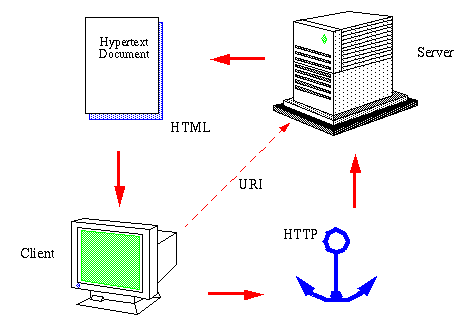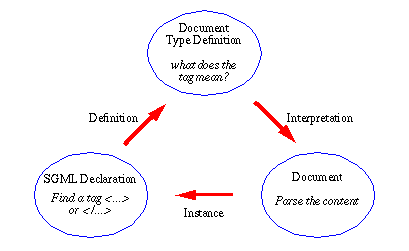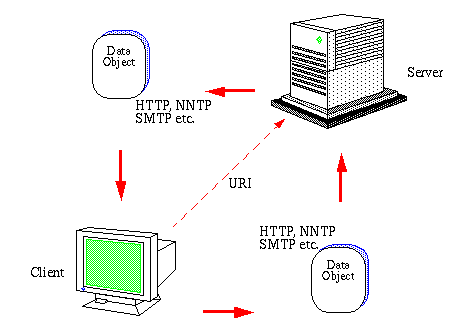Henrik
Frystyk, July 1994
 The World-Wide Web
The World-Wide Web
 The official description of the World-Wide
Web (WWW, W3) is a "wide-area hypermedia information retrieval
initiative aiming to give universal access to a large universe of
documents". It is a way of viewing all the on-line information
available on the Internet as a seamless, browsable continuum. This
section introduces the general concept of the World-Wide Web and the
basic elements in the model. The content of the section is as follows:
The official description of the World-Wide
Web (WWW, W3) is a "wide-area hypermedia information retrieval
initiative aiming to give universal access to a large universe of
documents". It is a way of viewing all the on-line information
available on the Internet as a seamless, browsable continuum. This
section introduces the general concept of the World-Wide Web and the
basic elements in the model. The content of the section is as follows:
- Basic World-Wide Web Model
- Universal Resource Identifies
- Hypertext Transfer Protocol
- Hypertext Markup Language
- Interactive World-Wide Web Model
Basic World-Wide Web Model
The basic idea behind the World-Wide Web is based on a client server
application and hypertext documents as illustrated in the figure
below. The model is simplified in that it only contains elements that
exists within the World-Wide Web concept. Later the model will be
expanded to a generic resource accessing model.

- The Client
- The client is the user's interface to the Internet. Whatever type
of service requested this interface stays the same, so users do not
need to understand the differences between the many different access
schemes in common use on the Internet. This principle is the same as
is seen from other popular applications such as Microsoft Windows,
Machintosh etc. where the user is always presented to the same GUI
interface.
- Uniform Resource
Identifier URI
- The user initiates a request by specifying a Uniform Resource
Identifier or a "hyperlink". This link can specify any accessible
information or resource on the Internet as long as it can be uniquely
identified as an object. The word "Web" refers to the combination of
accessible objects and the links pointing to them throughout the
Internet.
- The
Server
- The server is responsible for handling the request sent from the
client. This can either be a local accessible resource or the server
can request the resource from another server in which case the first
server temporarily turns into a client.
- Hypertext
Transport Protocol HTTP
- The client sends of the user request to a WWW server using the
Hypertext Transfer Protocol (HTTP). This is a typical client-server
application based on a stateless connection between the client
requesting the URI and the server handling the request.
-
Hypertext Markup Language HTML
- On a successful request, a data object is returned from the
server to the client. The object is written in the Hypertext Markup
Language (HTML) which is a hypertext language with the possibility of
containing hyperlinks that the user can follow.
The model basically reflects the first version of the World-Wide Web
as it is described in the HTTP Protocol version 0.9 and HTML version
1.0. However, the WWW specifications have been rapidly changing during
the last 3-4 years, even though the current model is still based on a
client-server approach. From being a HTML and HTTP based model, the
World-Wide Web is now capable of handling virtually any existing data
format on the Internet using a large set of access methods apart from
HTTP such as FTP, Gopher, WAIS, Telnet etc. In
other words, the World-Wide Web represents a generic information
exchange tool capable of accessing information throughout the
Internet. Though, before the more advanced model is presented, it is
necessary to get an overview of the basic elements in the WWW model
mentioned above.
Universal Resource Identifies
In order to address a data object or more general, a resource, in the
model above it is necessary to define a name space that not only
contains information about hosts but also about resources available on
each host. The World-Wide Web model defines Uniform Resource
Identifiers or URIs that specifies a syntax for encoding the names
and addresses of data objects on the Internet and how they can be
accessed. The set of URIs covers

- Universal Resource Identifier (URI)
- A generic set of all addresses in the address space of all
resources on the Internet. They describe a hierarchical naming scheme
that together with the HTTP protocol makes a
significant difference between the World-Wide Web model and other
Internet access schemes such as FTP that has a flat address space.
- Uniform Resource Locator (URL)
- The term "URI" has been introduced by the IETF and is a a general description of
all URL that are not persistent. In practice the URLs consist of the
current set of Internet protocols supported by the WWW, i.e, HTTP,
FTP, Gopher, WAIS, etc., followed by a directory path, a file name,
and possibly a search directive.
- Uniform Resource Name (URN)
- However, the ultimate goal for URIs is to be a persistent naming
scheme independent of the mean of access, i.e., the protocol used and
of the physical structure of resources on the specific host. The only
way to obtain this is to have a naming scheme like the Internet Domain Name Service. URNs are
currently under consideration in IETF
but little is known about the status of the research.
- Uniform Resource Citation (URC)
- This is meta information about a URI. They consist of pairs of
attribute/value which can contain information on the author, publisher
etc. The URC are currently not used.
Hypertext Transfer Protocol
The
Hypertext Transport Protocol (HTTP) is a generic stateless
presentation layer protocol with elements from other Internet presentation layer protocols.
The HTTP protocol is built on a client-server model where the client
initiates a request and the server replies with a response.
The basic format of the HTTP protocol is based on the MIME Protocol with a set of HTTP
Headers possibly followed by a message body containing a data
object in any 7-bit or 8-bit accepted by the client. The client
specifies what data format it can handle by having a list of
accept headers in the request.
The basic WWW-model indicates that the client
initiates a request and the server responds by sending a data object
to the client. However, often the client wants to post a data object
to the server, e.g. to post a mail message to an email address, to a
news group, or to create a new file on the remote server. The HTTP
protocol provides two methods for the client to transfer a data object
to the server. Though, the client is not guaranteed that the request
can be fulfilled - even on a successful return code. The action can at
all times be cancelled by the responsible person of the remote server.
One of the characteristics of the HTTP protocol is that it is a
superset of the other Presentation
Layer supported by the WWW-model. This means that messages
generated by other protocols can be handled by the HTTP protocol by
wrapping a set of HTTP/MIME headers around the message. This is an
essential feature for the
concept of Proxy servers.
The current version 1.0 of the HTTP protocol is built on top of the TCP Protocol that is a connection oriented
protocol with a 3 way handshake
connection establishment. This causes an substantial overhead in a
client-server oriented environment like the HTTP protocol. It would
therefore be an excessive optimization if the HTTP protocol was moved
to a lighter Transport Layer protocol such as the Transactional TCP Protocol which still
provides a reliable stream transport service.
Hypertext Markup Language
The Hypertext Markup language (HTML) is the users interface to
create information on the World-Wide Web. The description of the
World-Wide Web has until now focused on the technology that due to
specifications and conventions provide the functionality necessary to
request and serve information across the Internet. HTML is defined to
be the hypertext language of communication which actually flows over
the network. There is no requirement that files are stored in HTML.
Servers may store files in any other formats and then generate a HTML
on the fly upon a client request. This gives the possibility of having
virtual documents instead of static documents on rapidly changing
information like weather reports etc. HTML can be used to represent:
- Hypertext news, mail, online documentation, and collaborative
hypermedia
- Menus and options
- Database query results
- Simple structured documents with inlined multi media elements
like images, audio and movie
- URI-Links to other resources on the Internet.
HTML is built on top of the International Standard ISO 8879 Standard
Generalized Markup Language (SGML). SGML is a system for defining
structured document types and markup languages to represent instances
of the document types. That is, HTML is a
Document Type Definition (DTD) used on top of a SGML parser. Every
SGML based document contains three elements as illustrated in the
figure:

HTML is now superseeded by
HTML+ that is an enriched DTD with possibilities of handling
tables, math, images etc. Currently many browsers support a subset of
the HTML+ specifications in addition to the basic HTML features.
Interactive World-Wide Web Model
The description of the Universal Resource
Identifiers, the Hypertext Transfer Protocol,
and the Hypertext Markup Language now calls for an
update of the Basic WWW-model as illustrated in
the figure.

This model is a generic resource exchange model based on a
client-server concept. Instead of the limited model with data flowing
only from the server to the client, the client is capable of posting
data to the server if the server allows this kind of service.
Furthermore, the format of the data transferred in the message body can
have any format from 7-bit ASCII text to 8-bit binary data. The
transfer carrier can be any protocol supported by the World-Wide Web
but the main protocol is HTTP as it can be used to encapsulate the
other protocols supported, even a FTP message that is a highly state
dependent protocol.
 Henrik
Frystyk, July 1994
Henrik
Frystyk, July 1994
 The official description of the World-Wide
Web (WWW, W3) is a "wide-area hypermedia information retrieval
initiative aiming to give universal access to a large universe of
documents". It is a way of viewing all the on-line information
available on the Internet as a seamless, browsable continuum. This
section introduces the general concept of the World-Wide Web and the
basic elements in the model. The content of the section is as follows:
The official description of the World-Wide
Web (WWW, W3) is a "wide-area hypermedia information retrieval
initiative aiming to give universal access to a large universe of
documents". It is a way of viewing all the on-line information
available on the Internet as a seamless, browsable continuum. This
section introduces the general concept of the World-Wide Web and the
basic elements in the model. The content of the section is as follows:




 Henrik
Frystyk, July 1994
Henrik
Frystyk, July 1994